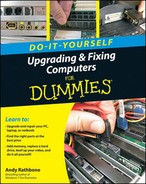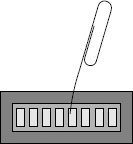The first tools to grab
Turning household items into tools
Using magnetized screwdrivers and dust blowers
Dealing with a lost manual
When you're at the computer shop, be sure to pick up a computer toolkit, if you don't already own one. The toolkits include most of the tools mentioned in this chapter and a snazzy, zip-up case to keep them in. Most kits cost less than $20 and include the right sized screwdriver, some handy tweezers, and the right-sized nut driver. If you don't want to spend money, you can probably salvage most of this chapter's handy items from a garage, junk drawer, kitchen, or laundry room.
But no matter whether you buy a toolkit or assemble your own, make sure that you keep it within reach when you're ready to open your computer's case.
This chapter tells you about these and other tools to put on your Computer Repair Shop wish list.
You'll find these essential tools in nearly every household, but if you don't, they're at your neighborhood hardware store. After you collect them, keep them together, and leave them within an arm's length of your computer. You'll constantly be reaching for them.
Phillips screwdrivers: Phillips screwdrivers have a little square cross on their tip, not a flat blade. The pointed tip fits directly into the crossed lines on the screw's top. Regular screwdrivers don't work.
The Phillips screwdriver doesn't need to be a tiny thing, as most computer screws have fairly deep holes. Sometimes an overeager computer nerd overtightens the screws that hold your computer's case together. In that case, a nut driver does a better job of removing it.
Tip
Just tighten screws enough so they won't come out by themselves. Don't overtighten them. In fact, overtightening the screws that hold in a hard drive can damage the drive.

When you want to insert a screw and you push its six-sided head into the six-edged nut driver, the screw usually stays put. From there, you can often guide the end of the screw to its target deep inside your computer, push it into the hole, and start turning. The socket end grips the screw the entire time, so the screw doesn't fall out. You can't do that with a Phillips screwdriver — even the ones with magnetized tips don't always grip as well as a nut driver.
A nut driver works well when unscrewing things, too. Again, the screw stays lodged inside the socket better than it would with a screwdriver, enabling you to lift it out of the computer's case without dropping it.
Tip
Almost all the screws lurking inside your computer — including the frequently accessed screws holding in the extension cards — work well with a quarter-inch nut driver.
Don't put these tools on your shopping list. No, you'll find them in nearly every house, and just about every office. After you've collected them, keep them with your other tools near your computer.
Paper clips: They don't look like much, but you'd be surprised what they can do when they're partially straightened. Then they come in handy for several things:
Making a stuck disc drive spit out its tray. Look for a tiny hole on the front of most disc drives — a hole much smaller than the headphone jack. If the disc gets stuck, try pushing the end of your bent paper clip into the hole. The hole serves as an Emergency Eject System that pushes out the tray, letting you retrieve your disc.
Prying jumpers off pins. Although needle-nose pliers work better for this, a paper clip is often handier, and it doesn't damage the pins. (You'll come across unruly jumpers when installing older hard drives and disc drives.)
Flipping DIP switches. DIP is short for dual inline package. These little rows of switches appear on some motherboards and hard drives. How do you flip those tiny things, shown in Figure 2-1? Grab the paper clip.
Empty egg cartons: An egg carton works great for holding screws from a computer's recently removed part. Drop screws from different parts into different depressions. Forgetful people label each depression with a pen so that they remember which screw attaches which part.
A small flashlight: Most of the stuff inside your computer's case is jammed pretty tightly together. When everything's dark inside, a flashlight helps you locate the right part, find a tiny printed model number, or locate missing screws.
Small key chain flashlights work well to illuminate your computer's crevices, as do the flashlights that are no bigger than a fountain pen.
Pad of paper and a pen: These come in handy for writing down part numbers, which you may need to look up later on Google.
The following items aren't crucial, but oh, they certainly are handy at the right times. If you spot one while shopping, think about buying it for an upcoming repair. They're both found at stores selling office supplies and computer parts.
A magnetized screwdriver: The magnet makes it easier to grab a fallen screw you've just spotted with the flashlight. Just touch the screw with the end of the screwdriver; when the screw sticks, gently lift it out with the screwdriver.
Compressed air canisters: Commonly found at stores selling office supplies and computer parts, compressed air canisters let you blow all the gross things out of the inside of your computer. They'll shoot the cat hairs out of a keyboard, as well. Pranksters can also squirt coworkers in the back of the head when they're not looking. Remember to recycle the can!
To avoid making a mess, take the computer outside before you blow the dust out of it. If you blow out the dust indoors, your computer's fan will eventually suck the particles back inside.
Warning
Don't blow with your own breath on your computer's innards to remove dust. Although you're blowing air, you're also blowing moisture, which can be even worse for your computer than dust.
Tip
Every few months, vacuum off the dust balls that clog the air vent on the back of your computer. The cooler you can keep your computer, the longer it lasts.
Everybody wants to cut down on their electricity bill. And going "green" — not using parts that suck more energy than needed — helps lower the monthly utility bill, as well. To see exactly how much power your computer consumes, you need a special tool: an electric usage monitor.
I bought a P3 International P4400 Kill A Watt electric usage monitor for less than 20 bucks on Amazon (www.amazon.com), and it's fascinating to use. Simply plug the Kill A Watt monitor into a wall outlet, then plug your computer (or anything else) into the Kill A Watt's outlet.
When you turn on your computer, the Kill A Watt's readout says exactly how much power is being consumed. Do this before and after installing a part to see what's changed.
This lets you know how much (or how little) your computer upgrade adds to your energy bill. Plus, by knowing exactly how many watts your computer draws, you'll know whether your computer's power supply is powerful enough to handle it, a subject covered in Chapter 10.
You did save all your computer's documentation, didn't you? Those manuals and papers come in handy when you're upgrading your computer. The documents describe the parts and model numbers of your computer's innards — essential information when trying to replace them. Keep the manuals in a safe place, preferably inside a large Ziploc freezer baggie.
Tip
But if you've lost the manual, it's not too late. Head to your computer manufacturer's Web site to see its vital statistics. Did you buy a Dell or Gateway computer? Find the computer's serial number on the sticker affixed to your computer's case, then head to www.dell.com or www.gateway.com for a list of your computer's parts and drivers. (You can sometimes find out whether your computer is still under warranty, too.)
Almost all computer manufacturers now offer their manuals for download as PDF files, readable with Adobe's Reader software (which is available for free at http://get.adobe.com/reader).
A working knowledge of the Internet helps you keep your computer running smoothly, no doubt about it. The Internet contains information posted by millions of computer users, and some of them have gone through the same problems you have. When you can't figure out an annoying error message, head for Google (www.google.com). Type the exact wording of the error message in quotes, and you'll find dozens of posts from people with the same problem. In many cases, you'll also find a post from somebody with a solution.
I describe how to diagnose and fix your computer through the Internet in Chapter 21.
Note
The Internet does you no good after you've installed a part and your computer stops working. Do your research before you start your fix-it job, or keep another computer handy for online research while upgrading.

